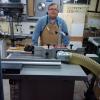Thanks. I have all that. What I'm pondering, is how to adjust the levellers from above the out feed table top, verse at the foot of the legs. I was thinking about using a pipe nipple to couple the height adjusters to a piece of all thread. Then I could just turn the all thread through a hole in table top. As the allthread rotates, it would drive the pipe nipple down, or pull it up - moving the leg foot up/down.
Or, I could just stop being lazy, kneel down to the floor, and use the levelling feet......




 Reply With Quote
Reply With Quote




